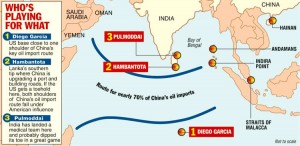Why the teardrop island is catching the eye of America and India:
New Delhi, March 10: The teardrop named Sri Lanka is threatening to light a fire in India’s backyard that New Delhi is hoping to douse by killing it with kindness.
The first steps of that policy has unfolded with a military-medical mission landing in Colombo this week in a first sortie by the Indian Air Force. More sorties are to be followed by a series of measures. The reconstruction package coincides with political pressures mounting from Tamil Nadu where Jayalalithaa went on a hunger strike demanding humanitarian intervention.
The demand is catching on during election time and has echoes in Washington where foreign secretary Shiv Shankar Menon met US secretary of state Hillary Clinton last night.

Lurking in the background of the measures that India is taking and the US is pushing for is an increasing presence of the Chinese who are developing roads, expanding a port and filling spaces vacated by India during the years of a hands-off policy before the Sri Lankan armed forces took the battle to the LTTE and cornered it in the island’s northeast where the militants’ territory is now confined to less than 100sqkm and is shrinking by the hour.
The demand for humanitarian intervention has been strengthened because aid agencies are saying that hundreds of thousands of non-combatants are caught between the guns of the Sri Lankan forces and the Tigers in two patches demarcated as no-fire zones. Each of these zones is roughly about 50sqkm, according to information exchanged by the Sri Lankan government with India.
In South Block, in the defence and external affairs ministries, officials are working on a package of measures that bear a resemblance to the kind of steps that India took in Afghanistan post-2001. Among these are an increase in the number of military-medical teams comprising field medical units. The first one is tasked to be deployed for a month.
Road rebuilding, de-mining, expansion of trade and economic ties, training and educational facilities are some of the other programmes on the agenda that New Delhi has set for a wider engagement with the Mahinda Rajapaksa government.
The US, meanwhile, is understood to have pushed for a more active engagement to evacuate civilians but there is little appreciation of where the evacuees can be taken to. The maritime great game over Sri Lanka is really unfolding around the evacuation of the civilians caught between guns and is not about them.
By landing an Indian military-medical team in Pulmoddai, 49km north of Trincomalee, the port in Sri Lanka’s east coast, India has probably put a foot into a situation where it foresees a landing of a number of foreign forces, benign or otherwise, while the US hovers in the background.
A British diplomat in New Delhi points out that western interest in Sri Lanka is currently driven by worries that the LTTE may attempt a terrorist strike in Europe or the US to draw attention to their plight in the face of the advance by Sri Lankan forces.
One strategic analyst in the Indian security establishment says there have been 14 bombings by the LTTE between November 13 and March 10 (including one in Matara today), more than half outside the LTTE’s traditional area of operations. The total number of LTTE workers (trained and semi-trained) is still estimated at 2000).
This still gives the LTTE a potential to strike at civilian targets. The US has a base in Diego Garcia, south of Sri Lanka, but its Pacific Command is not actively engaged in any large-scale land-based operation.
Analyst and writer Robert Kaplan foresees US policy in the latest Foreign Affairs journal as a mediator but the US “will have to do so not, as in Afghanistan and Iraq, as a land-based, in-your-face meddler, …but as a sea-based balancer lurking just over the horizon. Sea power has always been less threatening than land power: as the cliche goes, navies make port visits, and armies invade”.
North of Diego Garcia is the Sri Lankan southern tip of Hambantota where the Chinese are upgrading a port as they are the port of Gwadar on Pakistan’s Makran Coast. (The offer was once made to India but New Delhi dragged its feet). The Chinese are also building or expanding three major roads in Sri Lanka — an expressway from the Katunayake Airport to Colombo, a 200-odd-km road from Ambapasa to Trincomalee and about 100km of road from Hambantota to another airport east of it.
Between Diego Garcia and Hambantota is the Sea Lane of Communication through which nearly 70 per cent of China’s oil imports pass. A refuelling station at Hambantota, for tankers and/or warships and/or other vessels give the Chinese a huge R&R (rest and recuperation) point in the vastness of the Indian Ocean before they take to the Straits of Malacca.
So much goes into the teardrop called Sri Lanka then that the civilians — and no one knows for certain how many there are — who weep are often lost sight of.
SUJAN DUTTA
source: Telegraphindia